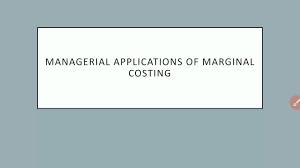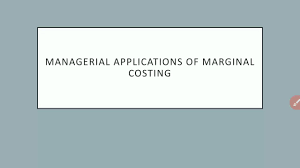APPLICATIONS OF MARGINAL COSTING

Marginal costing is a technique of ascertaining cost used in any method of costing. According to this technique, variable costs are charged to cost units and the fixed cost attributable to the relevant period is written off in full against the contribution for that period. Contribution is the difference between sales value and variable cost. The following are the Applications of Marginal Costing:
1. FIXATION OF SELLING PRICE:

Price is one of the most significant factor that determines the market for the products as well as the volume of profit for the organization. Under, normal circumstances, the price of a product must cover the total costs of the product plus a margin of profit. However, under certain special circumstances, price has to be fixed even below the total cost.
For instance, when there is a general trade depression (or) exploring new markets (or) accepting additional orders, the producer has to cut the price even below the total costs of the concerned product.
Under these special circumstances, the concept of marginal cost is usefully applied to fit the prices.
2. ACCEPTING BULK ORDERS (OR) FOREIGN MARKET ORDERS
Some bulk orders may be received from local dealers (or) foreign dealers asking for a price which is below the market price. This calls for a decision to accept (or) reject the order. The order from a local dealer should not be accepted at a price below the market price because it will affect the normal market and goodwill of the company on the other hand, the order from the foreign dealer should be accepted because it will give additional contribution, as the fixed costs have already been met.
3. MAKE (OR) BUY DECISION

When the management is confronted with the problem whether it would be economical to purchase a component or a product from outside sources, or to manufacture it internally, marginal cost analysis renders useful assistance in the matter. Under such circumstances, a misleading decision would be taken on the basis of the total cost analysis. In case the proposal is to buy from outside then, what is already being made, and the price quoted by the outsider should be lower than the marginal cost.
If the proposal is to make something what is being purchased outside, the cost of making should include all additional costs like depreciation on new plant, interest on capital involved and that cost should be compared with the purchase price.
4. SELECTION OF SUITABLE PRODUCT MIX
When a factory manufacturers more than one product, a problem is faced by the management as to which product will give maximum profits. The solution is the products which give the maximum contribution are to be retained and their production should be increased.
5. KEY FACTOR

It is also known as limiting factor (or) governing factor or scarce factor. A key factor is one which restricts production and profit of a business. It may arise due to the shortage of material, labour, capital
plant capacity (or) sales. Normally, when there is no limiting factor, the selection of the product will be on the basis of the highest P/V ratio. But, when there are limiting factors, selection of the product will be on the basis of the highest contribution per unit of the key factor.
6. MAINTAINING A DESIRED LEVEL OF PROFIT
A company has to cut prices of its products from time to time because of competition, Government regulations and other compelling reasons. The contribution per unit on account of such cutting is reduced while the industry is interested in maintaining a minimum level of its profits. In case the demand for the company’s product is elastic, the maximum level of profits can be maintained by pushing up the sales. The volume of such sales can be found out by marginal costing techniques.
7. ALTERNATIVE METHODS OF PRODUCTION
Marginal costing is helpful in comparing the alternative methods of production i.e., machine work (or) hand work. The method which gives maximum contribution is to be adopted keeping in mind the limiting factor.

8. DETERMINATION OF OPTIMUM LEVEL OF ACTIVITY
The technique of marginal costing helps the management in determination the optimum level of activity. To make such a decision, contribution at different levels of activity can be found. The level of activity which gives the highest contribution will be the optimum level. The level of production can be raised till the marginal cost does not exceed the selling price.
9. EVALUATION OF PERFORMANCE
Evaluation of performance efficiency of various departments or product lines can be made with the help of marginal costing. The management has to discontinue the production of non-profitable products or department so as to maximize the profits. In such cases, decision to discontinue will be on the basis of the lowest contribution or P/V Ratio.
10. COST CONTROL
The two types of costs-variable and fixed are controllable and non-controllable respectively. The variable cost is controlled by production department and the fixed cost is controlled by the management.
11. CLOSURE OF A DEPARTMENT OR DISCONTINUING A PRODUCT
Marginal costing technique shows the contribution of each product to fixed costs and profit. If a department or a product contributes the least amount, then the department can be closed (or) its production can be discontinued. It means the product which gives a higher amount of contribution may be chosen and the rest should be discontinued.
12. PROFIT PLANNING

There are four ways in which profit performance of a business can be improved:
(a) by increasing volume;
(b) by increasing selling price;
(c) by decreasing variable costs; and
(d) by decreasing fixed costs.
Profit planning is the planning of future operations to attain maximum profit or to maintain a specified level of profit. The contribution ratio (which is the ratio of marginal contribution to sales) indicates the relative profitability of the different sectors of the business whenever there is a change in selling price, variable costs or product mix. Due to the merging together of fixed and variable costs, absorption costs fail to bring out correctly the effect of any such change on the profit of the concern.
13. INTRODUCTION OF A NEW PRODUCT
A production firm may add additional products with the available facility. The new product is sold in the market at a reasonable price, in order to sell it in large quantities. It may become popular. If favorable, the sales can be increased. Thus, the total cost comes down and contributes some amount towards fixed costs and profits.
14. CHOICE OF TECHNIQUE
Every management wishes to manufacture the products at the most economical way. For this, the marginal costing is a good guide as to the products at different stages of production, that is to say whether the management has to adopt hand operated system (or) semi-automatic system or complete automatic system. When operations are done manually, fixed cost will be lower than the fixed cost incurred by machines and in complete automatic system, fixed costs are more than variable cost.
15. DECISION MAKING
Price must not be less than total cost under normal conditions, Marginal costing acts as a price fixer and a high margin will contribute to the fixed cost and profit. But this principle cannot be followed every time. Price should be equal to marginal cost plus a reasonable amount, which depends upon demand and supply, competition, policy of pricing etc.
If the price is equal to marginal cost, then there is a loss equal to fixed costs. Sometimes, the businessman has to face loss when
- There is cut-threat competition
- There is the fear of future market
- That goods are of perishable nature d) the employees cannot be removed
- A new product is introduced in the market
- Competitors cannot be driven out etc.
16. OFFERING QUOTATIONS
One of the best ways for sales promotion is to offer quotations at low rates. A company is producing 80,000 units (80% of capacity) and making a profit of 2,40,000. Suppose the Punjab Government has given a tender notice for 20,000 units. It is expected that the units taken by the Government will not affect the sale of 80,000 units which the company is already selling and the company also wishes to submit the lowest possible quotation. The company may quote any amount above marginal cost, because it will give an additional marginal contribution and hence profit.
